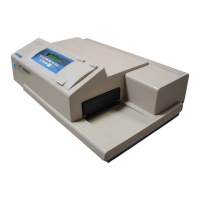Principles of Operation
20 0112-0115 F
Microplate readers use a vertical light path so the distance of the light
through the sample depends on the volume. This variable pathlength
makes it difficult to perform extinction-based assays and also makes it
confusing to compare results between microplate readers and
spectrophotometers.
The standard pathlength of a cuvette is the conventional basis for
quantifying the unique absorbtivity properties of compounds in
solution. Quantitative analyses can be performed on the basis of
extinction coefficients, without standard curves (for example, NADH-
based enzyme assays). When using a cuvette, the pathlength is known
and is independent of sample volume, so absorbance is proportional to
concentration.
In a microplate, pathlength is dependent on the liquid volume, so
absorbance is proportional to both the concentration and the
pathlength of the sample. Standard curves are often used to determine
analyte concentrations in vertical-beam photometry of unknowns, yet
errors can still arise from pipetting the samples and standards. The
PathCheck
®
Pathlength Measurement Technology feature automatically
determines the pathlength of aqueous samples in the microplate and
normalizes the absorbance in each well to a pathlength of 1 cm. This
novel approach to correcting the microwell absorbance values is
accurate to within 2.5% of the values obtained directly in a 1 cm
cuvette.
Figure 2-1 Cuvette and microwell light paths.
Reference measurements made by reading the cuvette (Cuvette
Reference) or using factory-stored values derived from deionized water
(Water Constant) can be used to normalize the optical density data for
microplate wells.
Pathlength correction is accomplished only when using the PathCheck
Pathlength Measurement Technology with SoftMax
®
Pro Software.
PathCheck Pathlength Measurement Technology is patented by
Molecular Devices and can be performed only on an Molecular Devices
plate reader.
Horizontal
light path
Vertical light path
Cuvette Microplate wells

